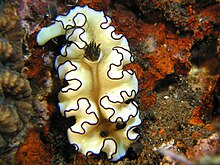Sea slug
group of marine invertebrates with varying levels of resemblance to terrestrial slugs
Sea slug is an informal name for a group of gastropods which look similar, but are not monophyletic. They are polyphyletic. Their similar shape and life styles is an example of convergent evolution. The group includes:
- Heterobranchia
- Nudibranchs: a clade with bilateral symmetry
- Sacoglossa, a clade of Heterobranch sea slugs and snails which go in for kleptoplasty ('stealing' plastids). They eat algae and keep the chloroplasts for their own use.
- Opisthobranchs: a long-used term now just an informal label.
- Sea angels, or cliones, are opisthobranch gastropod molluscs of the clade Gymnosomata.
- Sea hares are medium to large size marine gastropod molluscs. They belong to two families of the Opisthobranchia.
- Cephalaspidea: a sub-order of Opisthobranch gastropod molluscs. They usually have a reduced internal shell.
- Onchidiidae: a family of air-breathing sea slugs.
| Sea slug | |
|---|---|

| |
| Nembrotha kubaryana feeding on tunicates | |
| Scientific classification | |
| Kingdom: | |
| Phylum: | |
| Class: | |
| (unranked): | clade Heterobranchia
|

It would seem that their similar growth pattern, with the loss of torsion, bilateral symmetry, reduction of the Gastropod shell, and somewhat similar life styles, evolved a number of times in the Gastropods.